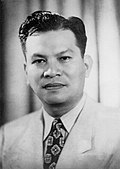| ||||||||||||||||||||
| Turnout | 77.22 ( | |||||||||||||||||||
|---|---|---|---|---|---|---|---|---|---|---|---|---|---|---|---|---|---|---|---|---|
| ||||||||||||||||||||
 Election results per province/city. | ||||||||||||||||||||
| ||||||||||||||||||||
1953 Philippine vice presidential election | ||||||||||||||||||||
| ||||||||||||||||||||
| ||||||||||||||||||||
| ||||||||||||||||||||
The 1953 Philippine presidential and vice presidential elections were held on November 10, 1953. [1] Former Defense Secretary Ramon Magsaysay was elected President of the Philippines, defeating Incumbent Elpidio Quirino in his run for a second full term. His running mate Senator Carlos P. Garcia defeated Quirino's running mate Senator José Yulo. Incumbent Vice President Fernando Lopez did not run for re-election. With Magsaysay's election as president, he became the first elected president that did not come from the Senate.
Contents
- Summary
- Nacionalista Party
- Liberal Party
- Results
- President
- Vice-President
- See also
- References
- External links
The election was free and fair. [2]







